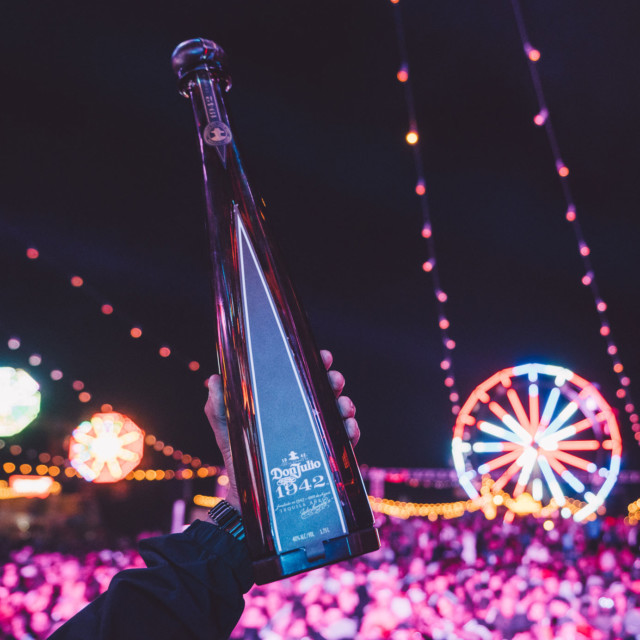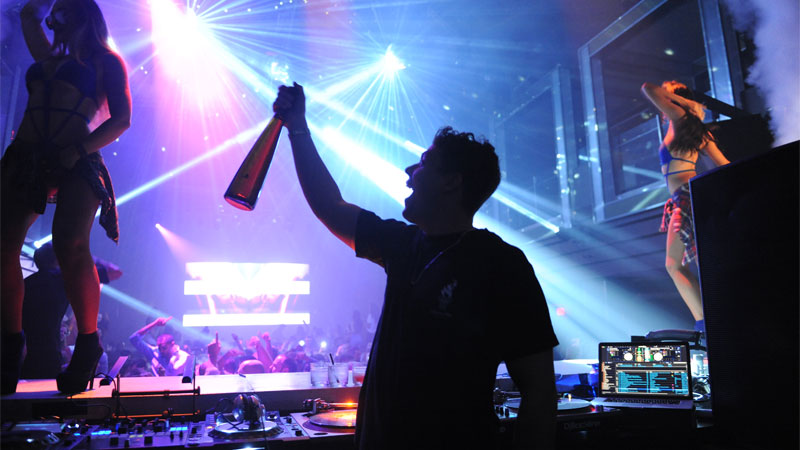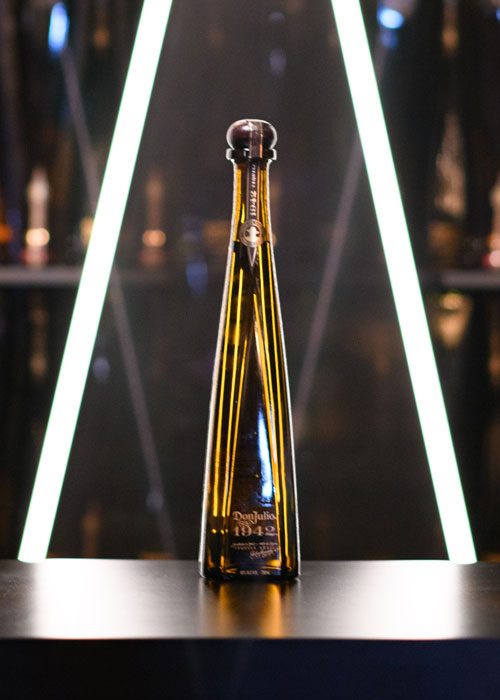As Kylie Jenner approached her 21st birthday in August 2018, many wondered how exactly the Gen Z model, reality TV star, and “almost-billionaire” would celebrate reaching legal drinking age. Jenner seemed to answer that very question 24 hours before the big day when, in an Instagram story shared to her then-audience of around 120 million followers, she posted a photo of a custom-engraved bottle of Don Julio 1942, along with the caption “AHHH 21 SOON 😎.”
The choice befitted both the individual and the occasion, not least because the paths of A-listers and agave distillates have become ever more entwined in recent years. Yet, Don Julio 1942 is its own, unique type of celebrity tequila — one owned not by a Hollywood actor but the world’s largest alcohol conglomerate. This bottle is a celebrity among tequilas.
Known to fans simply as “1942,” contemporary hip-hop artists namedrop the smooth sipping añejo in their rhymes, while its signature agave-leaf-shaped bottle makes regular appearances on the big and small screens. That one of the world’s most famous 20-year-olds would therefore celebrate her 21st by popping this specific bottle of Don seems particularly on-brand. And yet, considering only the tequila’s star-studded association distracts from a larger, even more impressive story.
While Don Julio 1942 started out as the darling of those with multi-million-strong social media followings, its popularity has since flowed into the mainstream. Americans seemingly can’t get enough of it. Retailers across the nation say they cannot keep 1942 on their shelves, even with the bottle’s hefty $150-plus price tag. With some now uttering its name in the same sentences as Blanton’s and Pappy Van Winkle, there can be no doubt about it: Don Julio 1942 is the first unicorn tequila.
Creating Celebrity Buzz
Don Julio 1942 launched in 2002 to mark 60 years since Don Julio Gonzalez founded the brand. The two-and-a-half-year-old añejo tequila debuted with a slightly wider bottle profile than today’s iteration, and bore an agave-blue-green label and portrait of Gonzalez. Only after a 2010 redesign, which saw the sleeker profile adopted (and by some accounts, a liquid reformulation), did the brand begin any real marketing push. The initial outreach was small and extremely targeted.
“It was almost like we were hand-selling it,” Christina Choi, senior vice president of Don Julio, recalls of the early efforts. After learning that certain celebrities, or “culture makers,” were Don Julio fans or tequila drinkers, the brand would reach out and offer intimate tastings or exclusive visits to the distillery, which is closed to the general public. The brand doled out lavish, personalized gifts, too.
In 2013, Don Julio started engraving bottles for its high-profile fans, with the first given to football-player-turned-TV- personality Michael Strahan for his 42nd birthday. Similar one-to-one relationships were forged with Derek Jeter, Lil Jon, Rihanna, and Ellen DeGeneres, among others. (In more recent years, as the brand’s popularity has grown, entrepreneurial types have turned to Instagram to sell their own custom-painted and decorated bottles of 1942.)
While it seems like a lifetime ago in social media terms, Instagram had been going for three years by 2013, and 12 months had already passed since Facebook shelled out $1 billion for the photo-sharing app. When Don Julio’s extended A-lister family and their entourages received their custom gifts and indulged in the luxury experiences, the platform therefore offered the perfect place to share them with their own followers. It was savvy influencer marketing before anyone thought to coin the term.
Don Julio ramped up the marketing in 2014, though still with careful consideration and celebrities at its core. The brand kicked off Super Bowl weekend with a celebration at the Diageo Liquid Cellar in New York, the host of that year’s big game. Over the course of the evening, the likes of Michael B. Jordan sipped añejo while enjoying performances from J. Cole, Naughty By Nature, DJ Ruckus, and DJ Politik. The latter two performers would later comprise half of Don Julio’s DJ ambassador program, known as the “1942 Crew.” (Choi tells me she likes to call them the “DJ Crew,” adding “pun intended.”)
The Super Bowl celebration marked the first in a series of major plays into wider celebrity and nightlife culture, now aided by the eponymous musical quartet. As the names got bigger over time, so too did the bottles. In January 2017, for example, Don Julio sponsored the annual TAO Park City pop up at the Sundance Festival. When John Legend arrived at his VIP table, a newly launched magnum bottle of Don Julio 1942 awaited on ice. Mary J. Blige and a group of friends would soon take a seat at the table next to him.
A Formula For Success
Beyond the celebrity buzz and glitzy soirees, Choi insists the key to 1942’s success has been the liquid inside the bottle. “The product itself — the quality of the product — it always has to start there,” she says. That sure sounds like something a brand’s SVP might say, but Choi is not alone in pointing to the tequila’s flavor as a factor in its popularity.
Carolyn Kissick is a Guadalajara-based partner at the consultancy firm Tequila Partners and director of consumer education and experience at SipTequila, a private tequila club. From the late 2000s to mid-2010s, she worked behind the bar at the TRES Tequila Lounge & Mexican Kitchen, a now-shuttered San Francisco destination for agave spirit lovers. Kissick says 1942’s profile, with its distinctive and approachable vanilla and hazelnut notes, made it an easy sell to Bay Area drinkers on a path of high-end tequila exploration.
At the time, that clientele mainly included “tech bros” celebrating selling their companies or raising a round of funding. “When a bunch of suits came in, you could basically just start lining up glasses of 1942 for them,” she says. “We actually sold it at $19 and 42 cents.”
The burgeoning popularity in the tech startup hub arrived even before the early celebrity adopters, between 2005 and 2015, Kissick says. “When I later moved into the VC world, you’d go into somebody’s office and they’d have a bottle on their desk or in their drawer,” she recalls. “They would call it by name: 1942.”
If venture capitalists and tech bros are a little more down to earth (in some respects) than Hollywood royalty, only in the last few years — and particularly the last 12 months — has Don Julio 1942 really captured the hearts and palates of the more general drinking populace.
“You wouldn’t think that a $150 bottle of tequila would be one that you just can’t keep on the shelves,” says Jamie Farris, owner of Hattiesburg, Miss.’s Lincoln Road Package Store. “We probably get six bottles a month, and those are all sold before they even come in the door.”
Farris says sales took off “exponentially” over the last year, and puts it down to the tequila’s profile, which hits a sweet spot that both bourbon drinkers and agave purists can appreciate. He’s more familiar with the former, of course, given that his store offers over 20 different barrel picks at any one time, a fact that has earned him the moniker “Store Pick King.” But while the phone still rings with Blanton’s inquiries 30 or 40 times per day, Don Julio is slowly catching up. “We get five to 10 phone calls a day about 1942,” he says.
Don Julio’s surge in popularity hasn’t been tied to clearly defined geographical boundaries, either. Google search volume for the term “Don Julio 1942 Tequila” is not highest in Los Angeles, New York, or even Texas, as you might assume. Instead, it peaks in Delaware, Illinois, and… Alaska.
In New Hampshire, sales of 1942 surged 64.8 percent over the last 12 months at the control state’s liquor and wine outlets, according to Joseph Mollica, chairman of the New Hampshire Liquor Commission (NHLC). Just like at Lincoln Road, those numbers could have been even stronger if the state didn’t have to contend with supply shortages. “Do I think it could have grown more?” Mollica says. “I really do.”
The popularity is easy to track, but what’s harder to explain is: Why now? Perhaps the fervor represents the culmination of Don Julio’s calculated, slow-burn marketing approach, and the manner in which the liquid has seeped into broader popular culture. If drinkers haven’t directly discovered the bottle on the social media accounts of their favorite celebrities, they might have spotted it alongside bottles of Rémy Martin XO and The Macallan 18 in the 2017 film “Molly’s Game,” for example, or while enjoying an episode of the TV drama “Billions.”
There’s also been a stream of musical references in recent years. Spotify offers its subscribers at least five singles recorded since 2016 with direct 1942 links in their name, from artists including Meek Mill and PARTYNEXTDOOR. This doesn’t even scratch the surface of countless other casual mentions of “sippin’ 1942,” as heard in songs like “Perfect Time” from the Compton rapper Roddy Ricch.
Keeping Up With Don Julio (Demand)
Whatever the reason, Don Julio has given itself quite the task when it comes to keeping up with demand. Where the product was averaging around 10,000 cases in the early 2010s, according to Don Julio’s Choi, it now sells “well over 200,000 cases” — the equivalent of around 2.5 million 750-milliliter bottles. To put those numbers into perspective, Don Julio 1942 was the fifth-best-selling tequila by volume over the last 12 months on both Wine.com and Drizly — not bad for a $150 bottle.
And the demand shows no sign of slowing. For the first 12 weeks of 2021, Don Julio 1942 saw the fourth-largest dollar sales growth of any spirit, according to off-premise data shared with VinePair by Dave Williams of Bump Williams Consulting. The bottle also finished that period as the fourth-best-selling tequila in terms of dollar sales. That’s higher than George Clooney’s Casamigos, higher than The Rock’s Teremana, and higher than every other celebrity-owned-or-associated tequila on the market.
Most analysts would surely note that the popularity of this celebrity bottle among tequilas links to a broader premiumization trend happening within the category right now. But when weighing up all the external cultural factors, one could reasonably counter by asking which is the chicken, and which the egg?
For NHLC’s Mollica, at least, there’s no doubt that Don Julio 1942 meets all the criteria that agave aficionados are currently craving. “They want something special. They want something unique. They want the Pappy Van Winkle of tequila,” he says.


